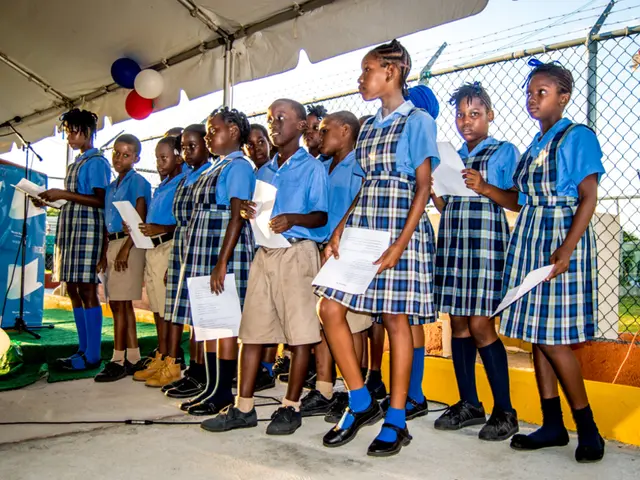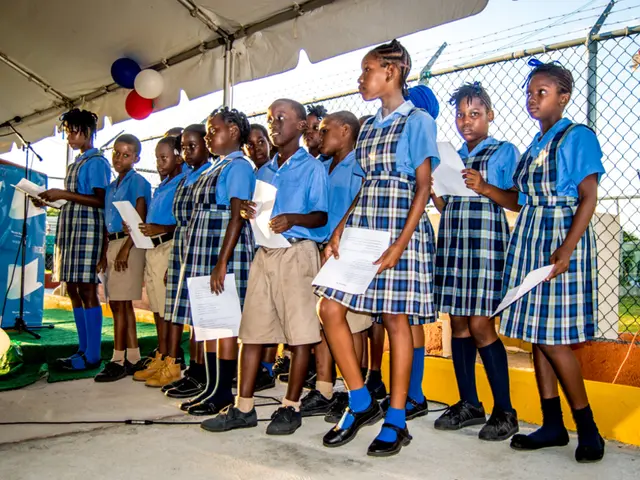Online Education vs. Conventional Schools: In-depth Examination of Education's Future Direction
The Education Landscape Evolves: A Closer Look at Traditional Schools vs Online Learning
In today's digitally-driven world, education is undergoing a noteworthy shift, instigating a renewed conversation about the merits of traditional education versus online learning. As technology reshapes knowledge dissemination and consumption, this debate zeroes in on crucial distinctions in methodologies, accessibility, and engagement.
Traditional education, characterized by face-to-face interactions and rigorous curricula, once reigned supreme as the pillar of academic development. However, the swell of online learning platforms presents an adaptable alternative appealing to a diverse range of learners.
A persistent question in this dialogue revolves around access to education. Traditional schools necessitate physical attendance, which, for students in remote areas or those with mobility issues, may restrict their learning opportunities. In contrast, online learning offers an inclusive system, erasing geographical barriers and enabling learners to draw from resources anywhere with an internet connection. As a result, pertinent questions about educational equity and the true capacity of online platforms to level the playing field are raised.
Engagement is yet another vital component in this debate. Supporters of traditional education cite the benefits of in-person social interactions and collaboration, arguing that these cannot be effortlessly replicated in virtual environments. In contrast, advocates for online learning emphasize the opportunities for personalized learning experiences, allowing students to progress at their own pace and tailor their educational paths based on their individual needs and interests.
Technological advancements cannot be overlooked in this discourse. As digital tools become increasingly integrated into educational practices, educators and policymakers are prompted to reconsider how these technologies may enhance or detract from learning outcomes. This ongoing change calls for an examination of both traditional schools and online learning environments as stakeholders seek to comprehend which approach best equips students for the challenges of the future.
The following sections delve deeper into the Hallmarks of Traditional Schooling and Online Learning, their respective Advantages and Disadvantages, and the Rise of the Hybrid Approach.
Traditional Schooling: An Enduring Legacy
Traditional schooling has served as the cornerstone of educational systems for centuries, evolving to shape the learning experiences of millions of students worldwide. Historical findings indicate that these institutions emerged to provide a structured space for knowledge dissemination, typically characterized by a fixed location and a consistent schedule.
The classroom setting, often comprised of rows of desks facing a teacher's workspace, fosters specific dynamics that influence both learning and behavior. In traditional environments, students usually participate in direct instruction, with teachers delivering course content and facilitating discussions.
Instructors' teaching methods in traditional schooling vary, but many subscribe to a teacher-centered approach. This convention empowers educators to serve as authoritative figures, leading students through standardized curricula that often align with state or national educational standards. Subjects like mathematics, language arts, and sciences are frequently included, providing students with a thorough grounding in essential knowledge. A structured timetable, usually divided into periods or blocks, promotes a sense of routine and aids in fostering time management skills.
One significant advantage of traditional schooling lies in its promotion of socialization among students. Daily interactions with peers fosters friendships and cultivates important interpersonal skills. Moreover, hands-on learning experiences, stemming from lab work, group projects, and extracurricular activities, deepen understanding and appreciation for academic concepts. These encounters are often heightened by sports, clubs, and other group activities, which contribute to a vibrant school community atmosphere.
However, traditional schools pose certain challenges such as large class sizes and varying teacher effectiveness, which can impact students' educational experiences and outcomes.
Online Learning: Breaking Down the Barriers
The advent of online learning has redefined the educational landscape, spurring rapid acceptance and popularity over recent years. Technological advancements and the increasing demand for flexible and accessible learning opportunities have fueled its expansion. Online learning allows students to pursue their studies from anywhere, making it an attractive alternative to fixed, physical classrooms.
Two primary types of online learning have emerged: Synchronous and Asynchronous learning. Synchronous learning occurs in real-time and encourages concurrent interactions between students and instructors, typically through live video lectures and discussions. In contrast, Asynchronous learning permits students to access course materials at their convenience, adopting a more self-paced approach to education.
Platforms such as Moodle, Blackboard, and Google Classroom facilitate a vast array of resources, including video lectures, interactive tutorials, quizzes, and discussion forums. The operation of these online learning environments hinges upon robust technological infrastructure and incorporates multimedia formats to enhance engagement and comprehension. By integrating resources like videos, infographics, and interactive simulations, educators can create engaging and dynamic learning experiences tailored to diverse learning styles.
Online learning also presents significant opportunities for personalized educational experiences. Through the ability to track individual progress, educators tailor course content to cater to unique learning needs, fostering more meaningful and effective learning journeys for each student. Such customization extends beyond academic pacing to flexible scheduling, enabling learners to balance multiple commitments and study at times that best suit their lifestyles.
Advantages and Disadvantages of Traditional and Online Learning
An examination of the benefits and drawbacks of traditional schools and online learning helps to better comprehend the changing educational landscape.
Traditional schools offer a range of advantages, including the immediate interaction between students and teachers, setting a structured learning environment, offering valuable opportunities for socialization and interpersonal skills development, and providing hands-on learning experiences.
However, traditional schools are also constrained by inflexible schedules, inequitable resource distribution, large class sizes, and varying teacher effectiveness, factors which can impact students' learning experiences and success.
Online learning delivers a more flexible, accessible, and personalized approach to education. By offering a broader range of courses and fostering self-paced learning, online platforms maximize the potential for diverse educational experiences. Yet, online learning comes with its share of disadvantages, primarily the potential for isolation, distractions, digital inequality, and ambiguity surrounding the value of online degrees in the job market.
The Hybrid Approach: Merging Traditional and Online Learning
The hybrid approach to education represents a creative synthesis of traditional schooling and online learning methodologies. This innovative model combines face-to-face interactions with the flexibility of digital resources, creating a dynamic learning environment that pairs the strengths of each teaching method.
A hybrid model is advantageous because it provides students with the benefits of structured learning environments, personalized attention, and innovative learning tools, while still offering the social engagement and peer interactions characteristic of traditional settings.
Some educational institutions have successfully implemented hybrid strategies, incorporating blended learning practices that leverage the best of both worlds. For instance, the flipped classroom approach enables students to explore theoretical concepts online before engaging in deeper discussions and practical applications in the classroom. This approach effectively reduces classroom time, boosts student engagement, and fosters critical thinking and collaborative skills.
The Future of Education: Shifting Landscapes and Emerging Trends
As we gaze into the future of education, several trends and predictions are poised to reshape the educational landscape. These changes include the continued integration of technology, an increased emphasis on personalized learning, shifting educational policies, and the increasing acceptance of online learning.
As institutions continue to embrace technology, artificial intelligence, virtual reality, and interactive platforms are set to play more significant roles in educational methodologies. This integration not only customizes learning experiences for diverse learning styles but enhances engagement and deepens student comprehension.
Personalized learning, especially when blended with technology, is increasingly being recognized as a powerful force in reshaping education. Advocates argue that this approach empowers learners to take charge of their education, foster autonomy, and prepare students to tackle the challenges of the modern workforce.
Educational policies may also evolve as stakeholders reconsider traditional frameworks and promote more inclusive and adaptable approaches. Flexible institutional structures that accommodate blended learning models and provide learners with diverse learning opportunities are expected to emerge.
Ultimately, the future of education will likely embrace a comprehensive and innovative approach, merging the strengths of traditional and online learning while prioritizing accessibility, flexibility, and personalization. As technology continues to evolve and reshape our world, education must remain agile and relevant to meet the needs of future generations.
In today's technology-driven world, traditional schools and online learning platforms are challenging each other as the primary methodologies in education. The debate focuses on key distinctions in methodologies, accessibility, and engagement.
Traditional schools, historically rooted in regular meeting times and locations, maintain a time-tested structure for knowledge dissemination. The classroom setting promotes direct instruction and social interaction among students. Meanwhile, the Swell of online learning presents a flexible alternative, overcoming geographical barriers and offering resources from anywhere with an Internet connection.
Hands-on learning experiences, extracurricular activities, sports, and clubs contribute to a vibrant school community atmosphere in traditional settings. However, challenges like large class sizes and fluctuating educator effectiveness can impact students' learning experiences and success.
Online learning offers various resources, such as video tutorials, quizzes, and discussion forums, in synchronous and asynchronous formats. Platforms like Moodle, Blackboard, and Google Classroom facilitate self-paced learning, catering to diverse learning needs and lifestyles. Yet, online learning may present isolation, distractions, and digital inequality, as well as doubts regarding the job market's acceptance of online degrees.
The hybrid approach combines face-to-face interactions, digital resources, and personalized learning. In this model, learners benefit from structured environments, personalized attention, interactive tools, and social engagement.
As technology integrates further into education, digital tools and platforms like artificial intelligence will customize learning experiences and foster deeper student comprehension. Personalized learning is expected to gain prominence, encouraging learners to have control over their education and prepare them for the modern workforce.
In the coming years, educational policies may adopt more flexible structures that accommodate blended learning models, offering students a range of diverse learning opportunities. Ultimately, the future of education will likely merge the strengths of traditional and online learning while emphasizing accessibility, flexibility, and personalization.







